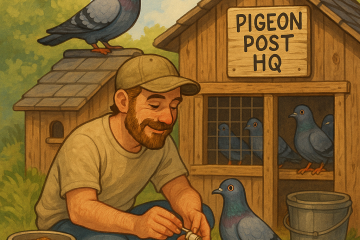
Pigeon Communication
When the internet goes down, most people panic, frantically waving their cell phones around like divining rods, searching for a signal that isn’t there. But not you. You’ve got a Plan B that flaps, coos, and occasionally redecorates your patio furniture: pigeons. Forget walkie-talkies—those need batteries. Pigeons? They’re the original feathered FedEx, and they don’t even complain about porch pirates.
How Do You Get a Pigeon to Deliver Mail?
This isn’t as simple as tying a note to a random bird and hoping it flies to your buddy’s house. Pigeons aren’t Uber drivers—they’re homing birds. That means they can only be trained to fly back to their home loft. The way to send a message is to keep your pigeons at the recipient’s place. When you want to communicate, you release one of their birds from your loft, and it will fly back to them with your note strapped on. If you both keep birds at each other’s places, you’ve got a two-way communication line—old-school texting with a side of cooing.
Training pigeons is surprisingly straightforward. You start by letting them out near the loft and slowly increase the distance over time. Within weeks, you’ll have feathered GPS units capable of finding home from dozens—even hundreds—of miles away. Just don’t expect same-day shipping if your bird decides to flirt with the neighbor’s flock along the way.
How Expensive Are Pigeons to Maintain?
Here’s the good news: pigeons are cheap dates. A starter flock of 6–12 birds might cost you anywhere from $50 to $200 depending on the breed (yes, pigeon enthusiasts are that into it). Their housing can be as simple as a well-ventilated loft or coop with a few perches. Feed is inexpensive—most folks give them a mix of grains like corn, wheat, or millet, and supplement with grit (tiny rocks that help them digest food). You’re looking at maybe $15–$30 per month for a small flock.
Compare that to the cost of a satellite phone subscription, and suddenly pigeons look like the Walmart rollback special of the communication world.
Do They Make Good Meat?
Ah yes, the elephant—or should I say squab—in the room. Pigeons have been on the menu for centuries, especially the younger birds, which are tender and rich in protein. The French even consider squab a delicacy (leave it to the French to make pigeon sound fancy). In a true survival scenario, pigeons can pull double duty: deliver messages by day, dinner by night. Just don’t eat the ones you still need for your “texting” plan—otherwise, you’ll be sending your next urgent note via smoke signal.
Why Pigeons Belong in Your Prepper Toolkit
At the end of the day, pigeons remind us that resilience isn’t about the newest gadget—it’s about the oldest wisdom. A flock of birds can give you communication in a blackout, low-cost protein, and maybe even an entertaining hobby. They’re quirky, resilient, and a little ridiculous… kind of like most of us preppers.
So next time someone laughs at your chicken coop, surprise them by saying, “Oh, those aren’t chickens. That’s my wireless carrier.” Then hand them a feather and whisper, “Unlimited data plan.”



0 Comments